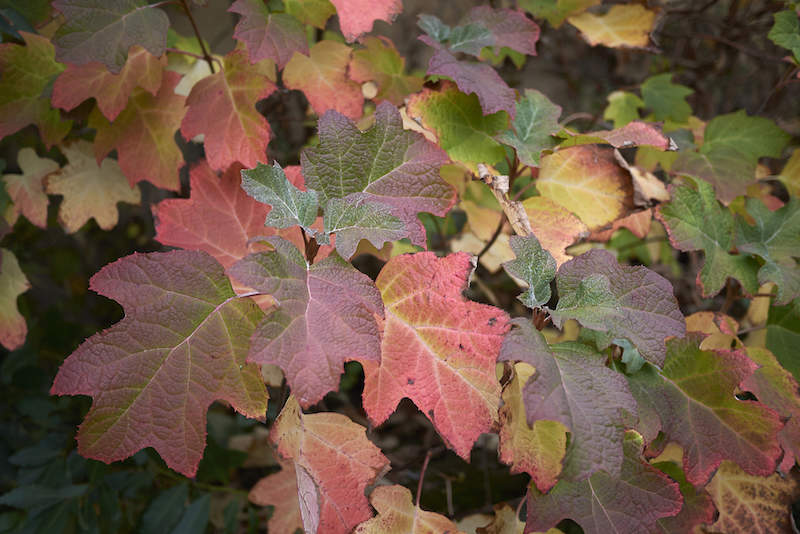Oakleaf Hydrangea: The Versatile Shrub That's
Oakleaf Hydrangea: The Versatile Shrub That's Perfect for Any Garden
Oakleaf hydrangea (Hydrangea quercifolia) is a beautiful and versatile shrub that can add interest to any garden. It is known for its large, lobed leaves that resemble those of an oak tree, as well as its large, cone-shaped clusters of flowers that bloom in late spring and early summer. Oakleaf hydrangeas are relatively easy to care for and can thrive in a variety of conditions, making them a good choice for both experienced and novice gardeners.
Here are some of the reasons why oakleaf hydrangeas are so popular:
- Beautiful foliage: Oakleaf hydrangeas have large, lobed leaves that are dark green on top and lighter green underneath. In the fall, the leaves often turn brilliant shades of red, orange, and purple.
- Long-lasting flowers: Oakleaf hydrangeas produce large, cone-shaped clusters of flowers that bloom in late spring and early summer. The flowers start out white and gradually turn pink or purple as they mature. The flowers can last for several weeks, depending on the weather.
- Versatile: Oakleaf hydrangeas can be used in a variety of settings, including foundation plantings, shrub borders, and woodland gardens. They can also be grown in containers.
- Easy to care for: Oakleaf hydrangeas are relatively easy to care for. They prefer partial shade and moist, well-drained soil. They should be watered regularly, especially during hot, dry weather. Oakleaf hydrangeas are not as susceptible to pests and diseases as some other types of hydrangeas.
If you are looking for a beautiful and versatile shrub that is easy to care for, oakleaf hydrangea is a great option. Here are some tips for planting and caring for oakleaf hydrangeas:
- Plant oakleaf hydrangeas in a location that receives partial shade. They can tolerate full sun, but they will do best in a location that receives some afternoon shade.
- Plant oakleaf hydrangeas in moist, well-drained soil. They will not tolerate soggy soil.
- Water oakleaf hydrangeas regularly, especially during hot, dry weather.
- Fertilize oakleaf hydrangeas in the spring with a balanced fertilizer.
- Prune oakleaf hydrangeas in the early spring, before new growth begins.
With proper care, oakleaf hydrangeas will thrive in your garden for many years to come. They are a beautiful and versatile addition to any landscape.
If you're looking for a beautiful and easy-to-care-for shrub for your garden, look no further than the oakleaf hydrangea (Hydrangea quercifolia). This native North American plant is known for its large, showy flowers that bloom in shades of white, pink, and blue. Oakleaf hydrangeas are also relatively low-maintenance, thriving in full sun to partial shade and well-drained soil.
If you're interested in learning more about oakleaf hydrangeas, I recommend visiting . This website has a wealth of information on the plant, including its history, care requirements, and varieties. You can also find helpful tips on how to plant, grow, and prune oakleaf hydrangeas.
FAQ of hydrangea quercifolia
- Q: What are the most important things to consider when planting hydrangea quercifolia? A: Oakleaf hydrangeas are relatively easy to grow, but there are a few things you need to keep in mind when planting them. First, they need full sun to partial shade. Second, they prefer moist, well-drained soil. Third, they are not very tolerant of salty or alkaline soil. Finally, they are susceptible to winter damage in cold climates.
- Q: How do I care for hydrangea quercifolia? A: Oakleaf hydrangeas are relatively low-maintenance plants. They need to be watered regularly, especially during hot, dry weather. You should also fertilize them once a year in the spring with a balanced fertilizer. In the fall, you can prune them back to about half their size to encourage new growth the following spring.
- Q: What are some common problems with hydrangea quercifolia? A: The most common problems with oakleaf hydrangeas are leaf spot, powdery mildew, and winter damage. Leaf spot is a fungal disease that causes brown spots on the leaves. Powdery mildew is also a fungal disease that causes a white powdery coating on the leaves. Winter damage can occur in cold climates if the plant is not protected from the cold.
- Q: How do I propagate hydrangea quercifolia? A: Oakleaf hydrangeas can be propagated from seed, but this is not the most reliable method. The best way to propagate them is from cuttings. Take cuttings in the spring or summer from healthy, new growth. Dip the cuttings in rooting hormone and plant them in a moist, well-drained potting mix. Keep the cuttings in a warm, shady location and they should root in a few weeks.
- Q: How do I overwinter hydrangea quercifolia in cold climates? A: If you live in a cold climate, you will need to protect your oakleaf hydrangeas from the cold in the winter. You can do this by covering them with a burlap sack or other protective material. You may also need to mound soil around the base of the plant to help insulate it.
Image of hydrangea quercifolia
5 different images of "hydrangea quercifolia" from Pinterest:
- A large oakleaf hydrangea in full bloom, with its dark green leaves and clusters of pink and white flowers.
- A close-up of the flowers of an oakleaf hydrangea, showing their delicate petals and intricate shape.
- A young oakleaf hydrangea shrub, with its dark green leaves and small clusters of pink buds.
- An oakleaf hydrangea in fall, with its leaves turning shades of red, orange, and yellow.

- A group of oakleaf hydrangeas planted in a garden, providing a splash of color in the late summer and fall.


Post a Comment for "Oakleaf Hydrangea: The Versatile Shrub That's"